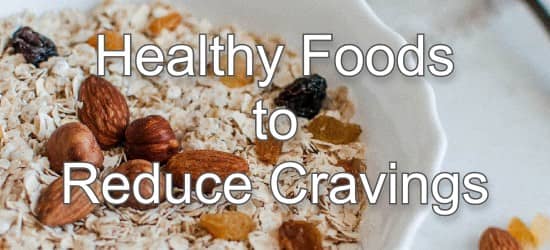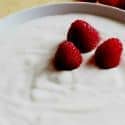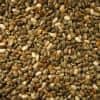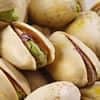Healthy Foods To Reduce Cravings (That Taste Good, Too)

A food craving is an intense desire for a specific food. It can feel uncontrollable and tends to be for unhealthy foods, high in sugar, salt, fat, or a combination of these. For anyone trying to manage their weight or simply stay healthy, food cravings can sabotage the best of intentions.
Food cravings have various causes including being overly hungry, tired, or sleep deprived. Low blood sugar levels, dehydration, hormones, stress, and other emotional factors also affect us. The good news is that there are various ways we can manage our diet and lifestyle to minimize cravings.
The basis for reducing cravings should always be a balanced diet, providing all the essential food groups and nutrients our bodies need for good health.
Keeping blood sugar levels balanced is also key to reducing cravings. When our blood sugar levels become too low, we can experience a range of symptoms including cravings for sugary foods, low energy, poor concentration, and irritability. Many of the foods listed here, therefore help with blood sugar regulation, while others help keep us feeling full and satisfied. In the further tips section below, you can find advice for managing the non-dietary reasons mentioned, such as sleep and stress.
Foods to Reduce Cravings
-
 1. Water + Add
Thirst signals can be confused with hunger signals (1), so simply staying hydrated and drinking plenty of water and other fluids throughout the day can help manage cravings. Sipping on 8 cups (2 liters) spread out across the day should be enough to manage cravings. Foods with a high water content such as soups, porridge, fruits, and vegetables are also useful, as they help keep you feeling full for longer (2).
1. Water + Add
Thirst signals can be confused with hunger signals (1), so simply staying hydrated and drinking plenty of water and other fluids throughout the day can help manage cravings. Sipping on 8 cups (2 liters) spread out across the day should be enough to manage cravings. Foods with a high water content such as soups, porridge, fruits, and vegetables are also useful, as they help keep you feeling full for longer (2).
Nutrition Facts for Tap Water. -
 2. Oats + Add
Oats and other whole grains are great for balancing blood sugar, as they release their energy slowly and gradually into the bloodstream. In contrast, refined carbohydrates such as white bread, white rice, and pastries release their energy quickly, causing blood sugar highs and lows, that can lead to cravings. Oats are especially good as they are high in soluble fiber, which is excellent for keeping you feeling full for longer (3).
2. Oats + Add
Oats and other whole grains are great for balancing blood sugar, as they release their energy slowly and gradually into the bloodstream. In contrast, refined carbohydrates such as white bread, white rice, and pastries release their energy quickly, causing blood sugar highs and lows, that can lead to cravings. Oats are especially good as they are high in soluble fiber, which is excellent for keeping you feeling full for longer (3).
Nutrition Facts for Cooked Oatmeal. -
 3. Cinnamon + Add
Cinnamon has been shown in some studies to help control blood sugar levels (4,5), which as mentioned, can help reduce cravings. The effects of cinnamon have been studied mainly in people with type 2 diabetes and pre-diabetes and it has shown promising effects on fasting blood glucose levels. An ideal breakfast could therefore be oatmeal porridge (see number 2 above), with cinnamon sprinkled on top plus some nuts, seeds, or yogurt for extra protein.
3. Cinnamon + Add
Cinnamon has been shown in some studies to help control blood sugar levels (4,5), which as mentioned, can help reduce cravings. The effects of cinnamon have been studied mainly in people with type 2 diabetes and pre-diabetes and it has shown promising effects on fasting blood glucose levels. An ideal breakfast could therefore be oatmeal porridge (see number 2 above), with cinnamon sprinkled on top plus some nuts, seeds, or yogurt for extra protein.
Nutrition Facts for Cinnamon. -
 4. Spinach + Add
Spinach and other green vegetables contain substances called thylakoids that have been shown to reduce hunger, increase satiety and reduce cravings for salty, sweet, and fatty snacks throughout the day (6). Thylakoids appear to promote the release of satiety hormones in the body, which leads to the aforementioned effects (7,8). The research has been done using extracts from leafy greens, but as these foods are also high in water, vitamins, and minerals, increasing their intake is certainly a good idea.
4. Spinach + Add
Spinach and other green vegetables contain substances called thylakoids that have been shown to reduce hunger, increase satiety and reduce cravings for salty, sweet, and fatty snacks throughout the day (6). Thylakoids appear to promote the release of satiety hormones in the body, which leads to the aforementioned effects (7,8). The research has been done using extracts from leafy greens, but as these foods are also high in water, vitamins, and minerals, increasing their intake is certainly a good idea.
Nutrition Facts for Cooked Spinach (Boiled, Drained). -
 5. Eggs + Add
To balance blood sugar levels, it is important to include some healthy protein with meals (and snacks), such as eggs, fish, tofu, or beans, in combination with slow-releasing carbohydrates (whole grains, sweet potatoes, and other starchy vegetables). This is the winning combination for keeping blood sugar levels balanced, appetite in check, and banishing those cravings. Eating two eggs for breakfast has also been shown in studies to increase satiety and reduce short-term food intake (9).
5. Eggs + Add
To balance blood sugar levels, it is important to include some healthy protein with meals (and snacks), such as eggs, fish, tofu, or beans, in combination with slow-releasing carbohydrates (whole grains, sweet potatoes, and other starchy vegetables). This is the winning combination for keeping blood sugar levels balanced, appetite in check, and banishing those cravings. Eating two eggs for breakfast has also been shown in studies to increase satiety and reduce short-term food intake (9).
Nutrition Facts for Hard Boiled Eggs. -
 6. Probiotics + Add
Live yogurt and other probiotic foods such as sauerkraut, kefir, and kimchi may help reduce cravings via their effects on gut bacteria. The balance of bacteria in the gut, known collectively as the 'microbiome' has far-reaching effects on many areas of health, including weight, appetite, and even food cravings. It is believed that certain bacteria could stimulate food cravings to motivate us to eat foods that either benefit them or suppress their competitors (as the gut environment is all about competition between different bacterial strains for space, food, etc) (10).
6. Probiotics + Add
Live yogurt and other probiotic foods such as sauerkraut, kefir, and kimchi may help reduce cravings via their effects on gut bacteria. The balance of bacteria in the gut, known collectively as the 'microbiome' has far-reaching effects on many areas of health, including weight, appetite, and even food cravings. It is believed that certain bacteria could stimulate food cravings to motivate us to eat foods that either benefit them or suppress their competitors (as the gut environment is all about competition between different bacterial strains for space, food, etc) (10).
Nutrition Facts for Non Fat Yogurt. -
 7. Pulses + Add
Pulses such as beans, chickpeas, and lentils contain the perfect balance of slow-releasing carbohydrates, protein, and fiber, making them great for blood sugar balance and keeping you feeling full. Both of these effects will help reduce the likelihood of food cravings. Research shows that eating meals containing pulses, does keep people feeling full and satisfied for longer (11).
7. Pulses + Add
Pulses such as beans, chickpeas, and lentils contain the perfect balance of slow-releasing carbohydrates, protein, and fiber, making them great for blood sugar balance and keeping you feeling full. Both of these effects will help reduce the likelihood of food cravings. Research shows that eating meals containing pulses, does keep people feeling full and satisfied for longer (11).
Nutrition Facts for Cooked Lentils (Boiled) (Mature Seeds). -
 8. Chia Seeds + Add
Chia seeds are a great source of satiating fiber, healthy fats, and plant protein. One study found that eating yogurt enriched with chia seeds as a mid-morning snack reduced hunger and desire for sugary foods while promoting satiety and reducing the amount eaten later that day (12). There is preliminary evidence that chia seeds may also support people trying to lose weight and improve various other health outcomes (13).
8. Chia Seeds + Add
Chia seeds are a great source of satiating fiber, healthy fats, and plant protein. One study found that eating yogurt enriched with chia seeds as a mid-morning snack reduced hunger and desire for sugary foods while promoting satiety and reducing the amount eaten later that day (12). There is preliminary evidence that chia seeds may also support people trying to lose weight and improve various other health outcomes (13).
Nutrition Facts for Chia Seeds. -
 9. Pistachios + Add
One study found that eating 1.5oz (42g) of pistachios every day for 4 months helped people manage their weight and reduced the number of sweets they ate (14). Another found that snacking on pistachios every day mid-morning for 12 weeks reduced hunger and increased satiety (15). Nuts in general tend to be a highly satisfying snack, helping people control their appetite and eat less.
9. Pistachios + Add
One study found that eating 1.5oz (42g) of pistachios every day for 4 months helped people manage their weight and reduced the number of sweets they ate (14). Another found that snacking on pistachios every day mid-morning for 12 weeks reduced hunger and increased satiety (15). Nuts in general tend to be a highly satisfying snack, helping people control their appetite and eat less.
Nutrition Facts for Dry Roasted Pistachio Nuts. -
10. Avocados + Add
One study found that eating avocados as part of a meal helped people feel more satisfied and reduced appetite following the meal. These effects were due to effects on satiety hormones and the hormone insulin, which is involved in blood sugar regulation (16). Another study found that eating half an avocado with lunch increased satiety by 23% and reduced the desire to eat by 28% for 3-5 hours (17).
Nutrition Facts for Avocados.
Tips for Reducing Cravings
- Regular eating - One of the most guaranteed ways to get cravings is being overly hungry. Regular eating is therefore key to preventing cravings. Ideally, we should be eating something every 4-5 hours. This means breakfast, lunch, and dinner are appropriately spaced out, plus 1 or 2 healthy snacks.
- Avoid ultra-processed foods - Widely available, ultra-processed foods can contribute to food cravings and obesity (18,19,20,21). This is in part due to their high content of unhealthy fats, sugar, and/or salt, making them highly palatable and setting up a desire to consume more and more. Avoiding or minimizing these foods and consuming a diet based on whole foods is therefore advisable to manage cravings and for overall health.
- Sleep - When we sleep well, the body releases higher levels of a hormone called leptin, which wards off hunger. When we are sleep-deprived, on the other hand, our bodies tend to produce more of a hormone called ghrelin, which increases appetite and desire for high-energy foods.(22)
- Exercise - Include exercise in your daily routine, as it has a positive effect on blood glucose control (23). In addition, exercise releases endorphins (happy chemicals) and helps manage stress.
- Manage stress - Try to manage stress and increase time for relaxation, as stress can disrupt blood sugar levels and increase food cravings (24). The stress hormone cortisol increases our drive to snack on high-calorie foods.
- Avoid fad diets - Restricting your food intake or limiting certain food groups, as advocated by many popular diets, is another sure way to set up a cycle of restriction, cravings, and over-eating (and even binging and disordered eating in some cases). Instead, focus on nourishing your body with the healthy foods it needs for good health.
Related
Data Sources and References
- McKiernan F, Hollis JH, McCabe GP, Mattes RD. Relationships between human thirst, hunger, drinking, and feeding J Am Diet Assoc. 2009 Mar;109(3):486-90. doi: 10.1016/j.jada.2008.11.027. 19248867
- Thondre PS, Shafat A, Clegg ME. Soups increase satiety through delayed gastric emptying yet increased glycaemic response Br J Nutr. 2013 Dec;110(12):2173-9. doi: 10.1017/S0007114513001682. Epub 2013 Jun 7. 23742725
- Rebello CJ, Johnson WD, Martin CK, Han H, Chu YF, Bordenave N, van Klinken BJ, O'Shea M, Greenway FL. Dietary fiber and satiety: the effects of oats on satiety J Am Coll Nutr. 2016;35(1):41-9. doi: 10.1080/07315724.2015.1032442. Epub 2015 Aug 14. 26273900
- Namazi N, Khodamoradi K, Khamechi SP, Heshmati J, Ayati MH, Larijani B. Efficacy and safety of cinnamon in type 2 diabetes mellitus and pre-diabetes patients: A meta-analysis and meta-regression Complement Ther Med. 2019 Apr;43:92-101. doi: 10.1016/j.ctim.2019.01.002. Epub 2019 Jan 9. 30935562
- Allen RW, Schwartzman E, Baker WL, Coleman CI, Phung OJ. The impact of cinnamon on anthropometric indices and glycemic status in patients with type 2 diabetes: A systematic review and meta-analysis of clinical trials Ann Fam Med. 2013 Sep-Oct;11(5):452-9. doi: 10.1370/afm.1517. 24019277
- Rebello CJ, Chu J, Beyl R, Edwall D, Erlanson-Albertsson C, Greenway FL. Consumption of thylakoid-rich spinach extract reduces hunger, increases satiety and reduces cravings for palatable food in overweight women J Am Coll Nutr. 2015;34(6):470-7. doi: 10.1080/07315724.2014.1003999. Epub 2015 Jun 1. 26029978
- Stenblom EL, Egecioglu E, Landin-Olsson M, Erlanson-Albertsson C. Acute Effects of a Spinach Extract Rich in Thylakoids on Satiety: A Randomized Controlled Crossover Trial Appetite. 2015 Aug;91:209-19. doi: 10.1016/j.appet.2015.04.051. Epub 2015 Apr 17. 25895695
- Köhnke R, Lindbo A, Larsson T, Lindqvist A, Rayner M, Emek SC, Albertsson PA, Rehfeld JF, Landin-Olsson M, Erlanson-Albertsson C. Effects of thylakoid intake on appetite and weight loss: a systematic review Scand J Gastroenterol. 2009;44(6):712-9. doi: 10.1080/00365520902803499. 19308799
- Ratliff J, Leite JO, de Ogburn R, Puglisi MJ, VanHeest J, Fernandez ML. Short-term effect of eggs on satiety in overweight and obese subjects Nutr Res. 2010 Feb;30(2):96-103. doi: 10.1016/j.nutres.2010.01.002. 20226994
- Moore A. Is eating behavior manipulated by the gastrointestinal microbiota? Evolutionary pressures and potential mechanisms Bioessays. 2014 Oct;36(10):905. doi: 10.1002/bies.201400146. 25205250
- Kim SJ, de Souza RJ, Choo VL, Ha V, Cozma AI, Chiavaroli L, Mirrahimi A, Blanco Mejia S, Di Buono M, Bernstein AM, Leiter LA, Kris-Etherton PM, Vuksan V, Beyene J, Kendall CW, Jenkins DJ, Sievenpiper JL. Dietary pulses, satiety and food intake: a systematic review and meta-analysis of acute feeding trials Am J Clin Nutr. 2016 May;103(5):1213-23. doi: 10.3945/ajcn.115.124677. Epub 2016 Mar 30. 27030531
- Ortinau LC, Hoertel HA, Douglas SM, Leidy HJ. Chia seed ( Salvia Hispanica L.) added yogurt reduces short-term food intake and increases satiety: randomised controlled trial Nutr J. 2014 Sep 29;13:97. doi: 10.1186/1475-2891-13-97. 25266206
- Vuksan V, Choleva L, Jovanovski E, Jenkins AL, Au-Yeung F, Dias AG, Ho HV, Zurbau A, Duvnjak L. Salba-chia (Salvia hispanica L.) in the treatment of overweight and obese patients with type 2 diabetes: A double-blind randomized controlled trial Eur J Clin Nutr. 2017 Feb;71(2):234-238. doi: 10.1038/ejcn.2016.148. Epub 2016 Dec 21. 28000689
- Rock CL, Flatt SW, Barkai HS, Pakiz B, Heath DD. Effects of Pistachio Consumption in a Behavioral Weight Loss Intervention on Weight Change, Cardiometabolic Factors, and Dietary Intake Nutr J. 2017 Dec 4;16(1):76. doi: 10.1186/s12937-017-0304-z. 29202751
- Carughi A, Bellisle F, Dougkas A, Giboreau A, Feeney MJ, Higgs J. Daily consumption of pistachios over 12 weeks improves dietary profile without increasing body weight in healthy women: A randomized controlled intervention Nutrients. 2019 Apr 2;11(4):767. doi: 10.3390/nu11040767. 30986958
- Dreher ML, Cheng FW, Ford NA. Using the Avocado to Test the Satiety Effects of a Fat-Fiber Combination in Place of Carbohydrate Energy in a Breakfast Meal in Overweight and Obese Men and Women: A Randomized Clinical Trial Nutrients. 2021 Dec 7;13(12):4376. doi: 10.3390/nu13124376. 34959933
- Dreher ML, Cheng FW, Ford NA. A randomized 3×3 crossover study to evaluate the effect of Hass avocado intake on post-ingestive satiety, glucose and insulin levels, and subsequent energy intake in overweight adults Nutrients. 2021 Dec 7;13(12):4376. doi: 10.3390/nu13124376. 34959933
- Pfinder M, Heise TL, Hilton Boon M, Pega F, Fenton C, Griebler U, Gartlehner G, Sommer I, Katikireddi SV, Lhachimi SK. Ultraprocessed Food: Addictive, Toxic, and Ready for Regulation Cochrane Database Syst Rev. 2020 Apr 9;4(4):CD012333. doi: 10.1002/14651858.CD012333.pub2. 32270494
- Rauber F, Steele EM, Louzada MLDC, Millett C, Monteiro CA, Levy RB. Ultra-processed food consumption and excess weight among US adults PLoS One. 2020 May 1;15(5):e0232676. doi: 10.1371/journal.pone.0232676. eCollection 2020. 32357191
- Juul F, Martinez-Steele E, Parekh N, Monteiro CA, Chang VW. Ultra-processed food consumption and indicators of obesity in the United Kingdom population (2008-2016) Br J Nutr. 2018 Jul;120(1):90-100. doi: 10.1017/S0007114518001046. Epub 2018 May 6. 29729673
- Nardocci M, Leclerc BS, Louzada ML, Monteiro CA, Batal M, Moubarac JC. Consumption of ultra-processed foods and obesity in Canada Can J Public Health. 2019 Feb;110(1):15-16. doi: 10.17269/s41997-018-0142-6. 30353503
- Kant AK, Graubard BI. Short sleep duration and dietary intake: epidemiologic evidence, mechanisms, and health implications Am J Clin Nutr. 2014 Sep;100(3):938-47. doi: 10.3945/ajcn.114.085191. Epub 2014 Jul 23. 25057157
- Pérez-López FR, Martínez-Domínguez SJ, Lajusticia H, Chedraui P; Health Outcomes Systematic Analyses Project. Effect of programmed exercise on insulin sensitivity in postmenopausal women: a systematic review and meta-analysis of randomized controlled trials Maturitas. 2017 Dec;106:38-47. doi: 10.1016/j.maturitas.2017.09.001. Epub 2017 Sep 4. 29150165
- Smithson EF, Hill AJ. Food cravings mediate the relationship between chronic stress and body mass index Eur J Clin Nutr. 2017 May;71(5):625-630. doi: 10.1038/ejcn.2016.235. Epub 2016 Dec 14. 27966566
Simplify Nutrition Tracking with MyFoodData!
Speedy Tools and Detailed Data FREEEasily analyze your meals to find the best foods for your goals.
✅ Use our recipe nutrition calculator and nutrition comparison tool.
✅ Access expert nutrition data tools and in-depth articles.
✅ Log foods and organize your recipes with a free account.


 Next ➞
Next ➞
